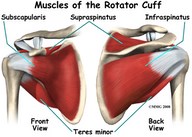
What is the Rotator Cuff?
 If you or someone you know has experienced shoulder problems then you may have heard one or all of the following terms: Rotor cup, rotar cuff, rotator cup, and rotary cuff. These are common mispronunciations for the group of muscles in the shoulder known as the rotator cuff. But what is it and what does it do?
If you or someone you know has experienced shoulder problems then you may have heard one or all of the following terms: Rotor cup, rotar cuff, rotator cup, and rotary cuff. These are common mispronunciations for the group of muscles in the shoulder known as the rotator cuff. But what is it and what does it do?
These questions, just like the name can be difficult. The rotator cuff is made of four different muscles. They are the supraspinatus, infraspinatus, teres minor, and subscapularis. Each of them originates on the scapula (shoulder blade) and then attaches to the humerus (arm bone).
The muscles work together to help stabilize and move the arm bone (humerus) in the socket (glenoid). The rotator cuff helps your shoulder initiate movements away from the body, rotate the arm in and out, and raise it out to your side.
It is a very important part of the shoulder for movement and function because of the shoulder's shape. Imagine a golf ball sitting on a tee. That is about the amount of contact between the two bones of your shoulder. The rotator cuff as well as the other shoulder muscles and ligaments help to hold the (golf ball and tee) joint together and allow it to move. These small rotator cuff muscles must work together to maintain this proximity of the shoulder bones and allow the larger shoulder muscles to move the arm. This is achieved by what is known as a force coupling. Simply put, the rotator cuff keeps the ball of the arm bone in a position that allows larger, stronger muscles to move and raise your arm against resistance. It is this relationship as a force couple that can frequently lead to injury.
It can be from repetitive use, poor posture, or accident that this fine balance of the shoulder is upset. The RC muscles are working any time you lift, push, pull, or carry with the arms. Because the other muscles around the shoulder are much larger and stronger, we frequently rely on them to perform our daily tasks. This creates tightness or imbalances in the shoulder that overtime can cause injury to the rotator cuff.
Our posture can also be a large contributor to shoulder problems. Many people sit in front of a computer or in the car for long periods of time. Often the position we sit in places the arms out in front of us causing the shoulder and upper back to be rounded forward. This forward position of the shoulders can increase strain and pressure on the rotator cuff. Lastly with falls, heavy lifting, or car accidents the arm is placed under more stress than it can handle and frequently the smaller rotator cuff muscles are injured.
So the next time you hear someone speaking of having trouble in their shoulder, remember the term rotator cuff. It's four small muscles that play a large part in moving and keeping the shoulder together.